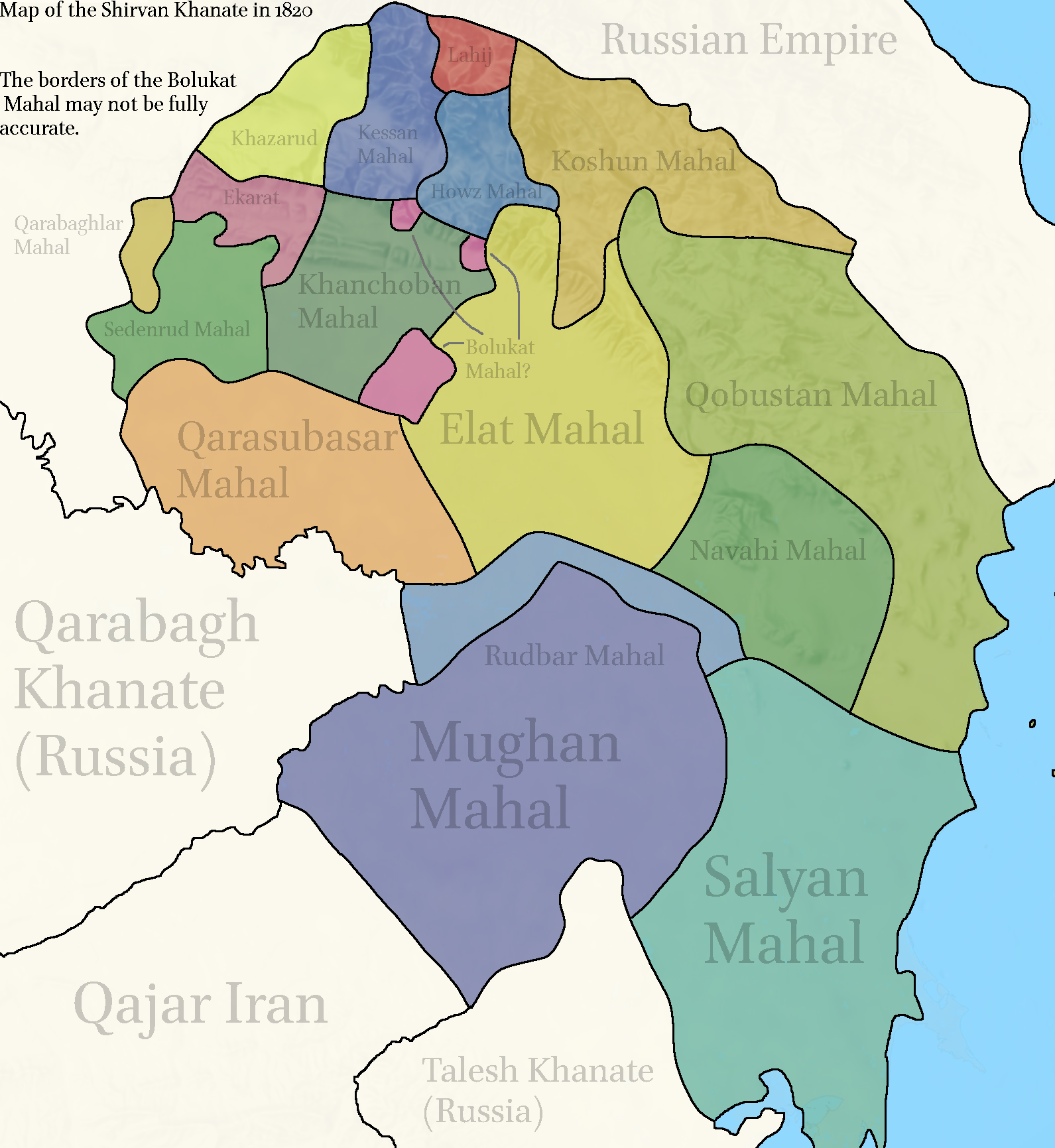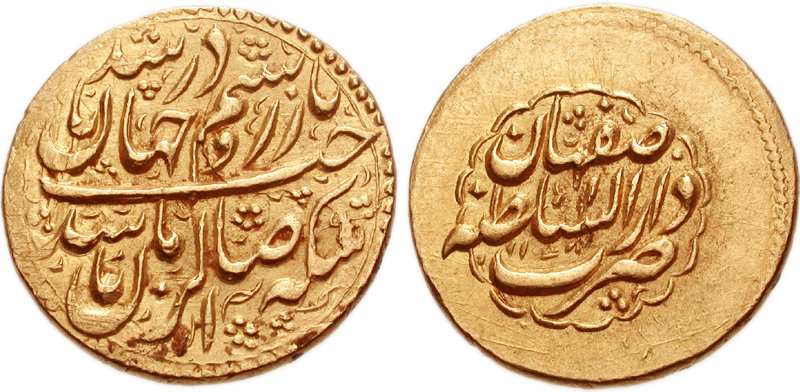|
Ibrahim-Khalil Khan Javanshir
Ibrahim Khalil khan Javanshir (1732–1806) was an Azerbaijani Turkic khan of the Karabakh Khanate from the Javanshir family, who succeeded his father Panah-Ali khan Javanshir as the ruler of the khanate. Early life He was born in c. 1732 in Karabakh. He was among deportees to Astarabad with his father Panah Ali Khan. He returned to Karabakh after Adil Shah issued a ''firman (decree)'' recognizing Panah Ali as the new khan. Participating in internal politics of his father, he was married with Hurizad, daughter of Armenian melik of Varanda - Shahnazar II, as a tool of marriage alliance. Panah Ali further wed him with Shahnisa, sister of Nazarali Khan Shahsevan of Ardabil and Tuti, daughter of Shahverdi Khan of Ganja in 1749. He was given as hostage to Fath-Ali Khan Afshar in 1759, who was defeated by Karim Khan Zand later. He was released by Karim Khan in 1759 and was allowed back to Karabakh. Reign He had to contest the khanate with Mehrali bey Javanshir, his younger b ... [...More Info...] [...Related Items...] OR: [Wikipedia] [Google] [Baidu] |
Karabakh Khanate
The Karabakh Khanate was a semi-independent Turkic peoples, Turkic Khanates of the Caucasus, Caucasian khanate on the territories of modern-day Armenia and Azerbaijan established in about 1748 under Safavid dynasty, Iranian suzerainty in Karabakh and adjacent areas. The Karabakh Khanate came under the control of the Russian Empire in 1805 during the course of the Russo-Persian War (1804–13). The Russian annexation of Karabakh was not formalized until the Treaty of Gulistan in 1813, when Fath-Ali Shah Qajar, Fath-Ali Shah of Qajar Iran officially ceded Karabakh to Tsar Alexander I of Russia. The khanate continued to exist under Russian suzerainty until its formal abolition in 1822, when the Karabakh Province, with a military administration, was formed. Russian control was decisively confirmed by the Treaty of Turkmenchay with Iran in 1828. History Background The precursor of the Karabakh Khanate, the Safavid Safavid Karabakh, province of Karabakh, was one of the provinces ... [...More Info...] [...Related Items...] OR: [Wikipedia] [Google] [Baidu] |
Melik Shahnazar II
Melik Shahnazar II ( hy, Մելիք Շահնազար Բ) was the melik of Varanda, one of the five Melikdoms of Karabakh, in the 18th century. He is a controversial figure in Armenian history, whose actions contributed significantly to the demise of Armenian Melikdoms of Karabakh. Early years Shahnazar's date of birth is unknown. He was of mixed Armenian and Turkman origin: his father was Melik Hussein of Varanda, while his mother was the daughter of the Khan of Nakhichevan, whom Melik Hussein had captured and married. He was the half-brother of Melik Hovsep Shahnazarian of Varanda. Accession to power Shahnazar killed his half-brother Melik Hovsep Shahnazarian and the latter's son Sahi Beg in 1750 and seized control of Varanda as Melik Shahnazar II. He sided with the chieftain of nomadic Sarijali branch of the Turkic Javanshir clan, Panah Ali, accepting his suzerainty and ceding the fortress of Shushi to him, after which Panah Ali made it the capital of the newfound Karabakh ... [...More Info...] [...Related Items...] OR: [Wikipedia] [Google] [Baidu] |
Amir Hamza III
Amir Hamza III ( Dargwa: ''Амир-Хlямза Уцуми'', ) was an khan of Kaitags who ruled Kaitag Utsmiate from 1751 to 1787. He was known as a significant military figure in the history of Dagestan and Transcaucasia in the 18th century. Reign The exact date of birth of Amir Hamza is unknown, but it is known that he was one of the three sons of Khan Muhammad, a military leader who predeceased his father Ahmad the Great. Amir Hamza had two brothers - Ustar and Sultan. As the grandson, he inherited Ulu Terekeme, Bashli, Berikey, Dzhemikent. Earliest mentions of Amir Hamza's reign dates back to 1751. He was related to other Caucasian rulers such as Umma Khan of Avars, Ghāzī Rustam of Tabasaran and Fatali Khan of Quba, who were his nephews and cousin respectively. Struggle with Derbent He became allied to Fatali Khan in 1760s, and joined his campaign against Derbent Khanate. Following a long siege, Amir Hamza with a small detachment was the first to enter Derbent ... [...More Info...] [...Related Items...] OR: [Wikipedia] [Google] [Baidu] |
Shirvan Khanate
Shirvan Khanate ( fa, خانات شیروان, Khānāt-e Shirvan) was a Caucasian khanate under Iranian suzerainty, which controlled the Shirvan region from 1761 to 1820. Background Under the Safavid dynasty of Iran, Shirvan was a leading silk manufacturer and its principal city, Shamakhi, became an important place for trade. In 1724, most of Shirvan was annexed to the Ottoman Empire by the Treaty of Constantinople. In 1734, the Iranian military leader Nader recovered Shirvan and installed Mohammad Mehdi Khan as its ''beglarbeg'' (governor-general). The following year, Mohammad Mehdi Khan was killed by rebellious dignitaries of the province. They had been incited by the governor of Darband, Morad-Ali Soltan Ostajlu. Mohammad Qasem Beg, who was a prominent dignitary of Shirvan and Nader's ''ishikaghasi-bashi'' (chamberlain), successfully appealed to Nader to pardon Shirvan. In 1735, Nader had the inhabitants of Shamakhi resettled in New Shamakhi ( Aqsu), situated 18 miles north ... [...More Info...] [...Related Items...] OR: [Wikipedia] [Google] [Baidu] |
Quba Khanate
The Quba Khanate (also spelled Qobbeh; fa, خانات قبه, Khānāt-e Qobbeh) was one of the most significant semi-independent khanates that existed from 1747 to 1806, under Iranian suzerainty. It bordered Caspian sea to the east, Derbent Khanate to the north, Shaki Khanate to the west, and Baku and Shirvan Khanates to the south. In 1755 the khanate conquered Salyan from the Karabakh Khanate. History The khans of Quba were from the Qeytaq tribe, which was divided into two branches, the Majales and the Yengikend. The origin of the tribe is obscure. First attested in the 9th-century, only their chieftain and his family were Muslims, according to the historian al-Masudi (died 956). The chieftain bore the Turkic title of ''Salifan'', as well as the title of ''Kheydaqan-shah''. According to the 17th-century Ottoman historian, Evliya Çelebi (died 1682), the Qeytaq spoke Mongolian, but this was dismissed as a "hoax" by the Iranologist Vladimir Minorsky (died 1966), who demonstra ... [...More Info...] [...Related Items...] OR: [Wikipedia] [Google] [Baidu] |
Avar Khanate
The Avar Khanate, the Avar Nutsaldom ( av, Avar Nutsallhi; russian: Аварское ханство), also known as Khundzia or Avaria, was a long-lived Avar state, which controlled mountainous parts of Dagestan (in the North Caucasus) from the early 13th century to the 19th century. History Between the 5th and 12th centuries, Georgian Orthodox Christianity was introduced to the Avar valleys. The fall of the Christian Kingdom of Sarir in the early 12th century and later weakening of neighbouring Georgians by the Mongol invasions, who made their first appearance in the Caucasus with approximately 20,000 warriors led by Subutai and Jebe, terminated further Christian Georgian presence in this area. In fact, numerous traces of Christianity (crosses, chapels) are found within the Avar territory and it is now assumed that Christianity, penetrating from Georgia, survived among the Avars down to the 14th-15th centuries. After ravaging Georgia, the Mongols cut across the Caucasus Mount ... [...More Info...] [...Related Items...] OR: [Wikipedia] [Google] [Baidu] |
Umma Khan V
Umma Khan V (Omar Khan) Avar nicknamed Great liev B.G. General R.F.Rosen’s work “Description of Chechnya and Dagestan” https://caucasushistory.ru/2618-6772/article/view/19/19/ Bulletin of the Institute of Economics of the Russian Academy of Sciences. 2017 or Mad (; 1761 or 1762, Khunzakh - March 22, 1801, Balaken) — Avar nutsal, ruler of Avar Khanate from 1774 to 1801. Under Khan, the Avar Khanate expanded its borders both by subordinating the Avar free societies, and at the expense of neighboring territories. Khan was paid tributes by the Georgian king Erekle II, Derbent, Quba, Baku, Shirvan, Shaki khans and Akhaltsikhe pasha Early life He was born in 1761, Avar village of Khunzakh to Muhammad IV, khan of Avars and his wife Bakha, daughter of Ahmad Khan, Utsmi of Kaitags. He had three full sisters and a half-brother named Gebek. His father Muhammad was a rival of Fatali Khan of Quba. He marched on Shamakhi in alliance with Aghasi Khan in 1774, however was forced t ... [...More Info...] [...Related Items...] OR: [Wikipedia] [Google] [Baidu] |
Karim Khan Zand
Mohammad Karim Khan Zand ( fa, محمدکریم خان زند, Mohammad Karīm Khân-e Zand; ) was the founder of the Zand Dynasty, ruling from 1751 to 1779. He ruled all of Iran (Persia) except for Khorasan. He also ruled over some of the Caucasian lands and occupied Basra for some years. While Karim was ruler, Iran recovered from the devastation of 40 years of war, providing the war-ravaged country with a renewed sense of tranquillity, security, peace, and prosperity. The years from 1765 to Karim Khan's death in 1779, marked the zenith of Zand rule. During his reign, relations with Britain were restored, and he allowed the East India Company to have a trading post in southern Iran. He made Shiraz his capital and ordered the construction of several architectural projects there. As noted by ''The Oxford Dictionary of Islam'', "Karim Khan Zand holds an enduring reputation as the most humane Iranian ruler of the Islamic era". When following the Islamic Revolution of 1979, the nam ... [...More Info...] [...Related Items...] OR: [Wikipedia] [Google] [Baidu] |
Fath-Ali Khan Afshar
Fath-Ali Khan Afshar ( fa, فتحعلی خان افشار), was a chieftain from the Afshars of Urmia, Afshar tribe of Urmia, and one of the four contenders for supremacy in Iran between 1751–1763. He was ultimately defeated and captured in February 1763 by one of the contenders, the Zand dynasty, Zand ruler Karim Khan Zand (). The latter had Fath-Ali Khan executed the following year, in July 1764. Background Fath-Ali Khan belonged to the Arashlu subgroup of the Afshar tribe. He was from the branch of Afshars that had populated the city of Urmia since the Safavid Iran, Safavid era. According to the modern historian P. Oberling, Fath-Ali Khan was "the most famous of the Afshar governors of Urmia." The Urmia Afshars played a big role in the violent wars that followed after the death of the shah (king) of Afsharid Iran, Iran, Nader Shah () in 1747. Biography Through extensive local support, Fath-Ali Khan was able to control all of the Azerbaijan (Iran), Azerbaijan province by 17 ... [...More Info...] [...Related Items...] OR: [Wikipedia] [Google] [Baidu] |
.png)

